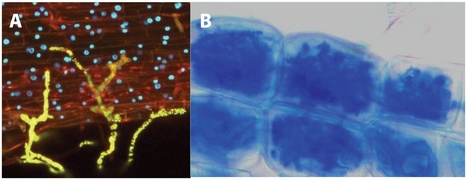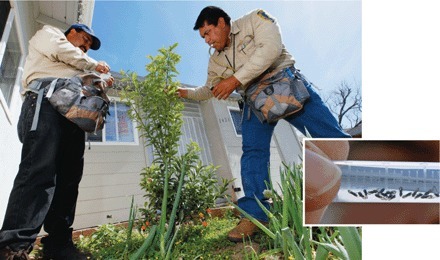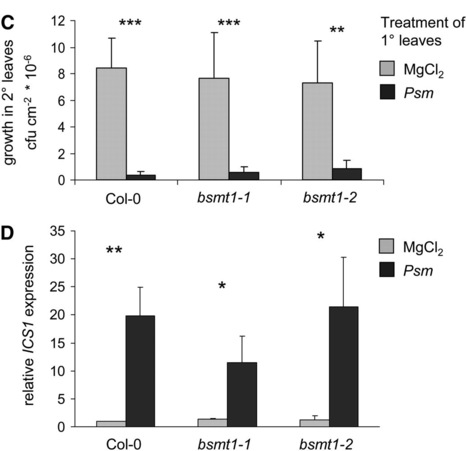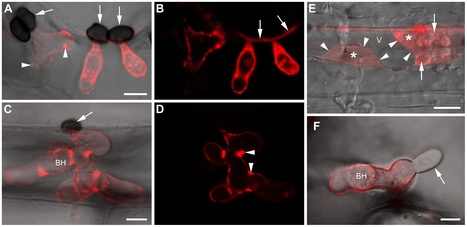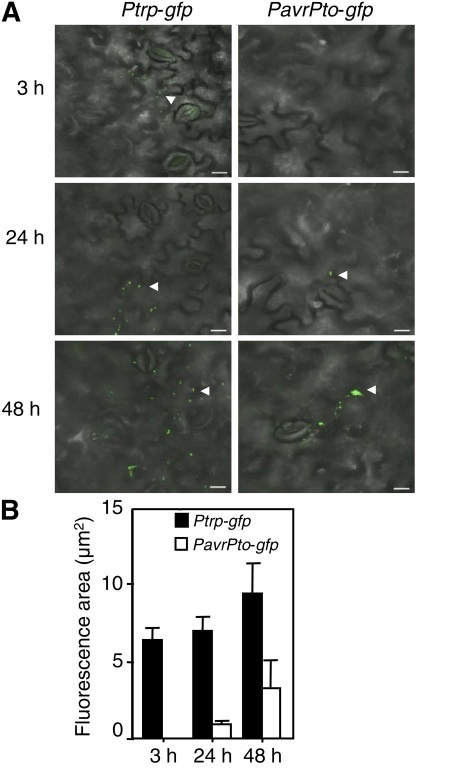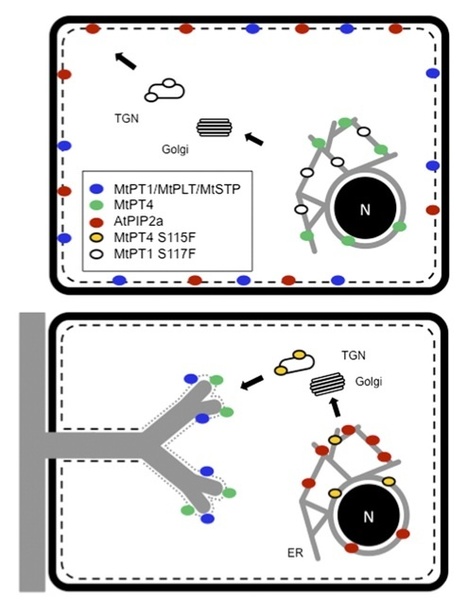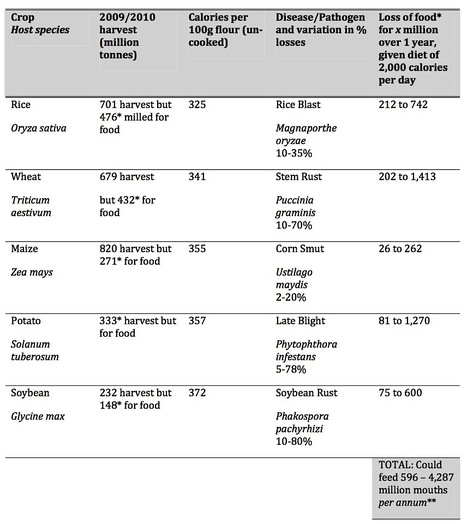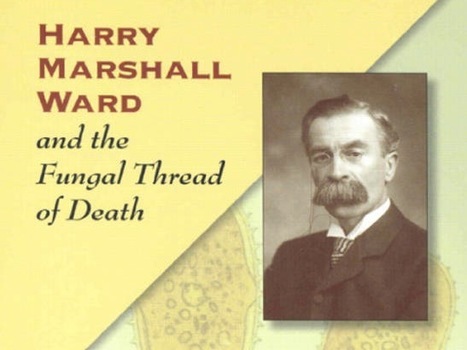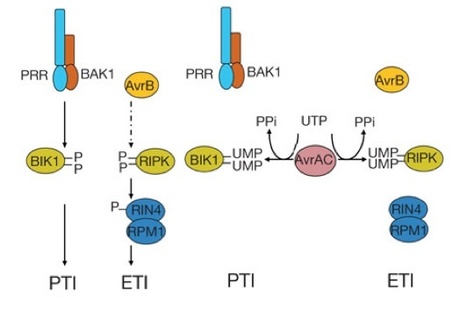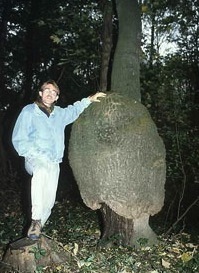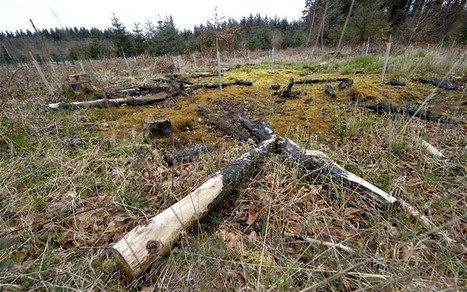 Your new post is loading...
 Your new post is loading...

|
Scooped by
Kamoun Lab @ TSL
April 26, 2012 6:32 AM
|
Much is known about the evolution of plant immunity components directed against specific pathogen strains: They show pervasive functional variation and have the potential to coevolve with pathogen populations. However, plants are effectively protected against most microbes by generalist immunity components that detect conserved pathogen-associated molecular patterns (PAMPs) and control the onset of PAMP-triggered immunity. In Arabidopsis thaliana, the receptor kinase flagellin sensing 2 (FLS2) confers recognition of bacterial flagellin (flg22) and activates a manifold defense response. To decipher the evolution of this system, we performed functional assays across a large set of A. thaliana genotypes and Brassicaceae relatives. We reveal extensive variation in flg22 perception, most of which results from changes in protein abundance. The observed variation correlates with both the severity of elicited defense responses and bacterial proliferation. We analyzed nucleotide variation segregating at FLS2 in A. thaliana and detected a pattern of variation suggestive of the rapid fixation of a novel adaptive allele. However, our study also shows that evolution at the receptor locus alone does not explain the evolution of flagellin perception; instead, components common to pathways downstream of PAMP perception likely contribute to the observed quantitative variation. Within and among close relatives, PAMP perception evolves quantitatively, which contrasts with the changes in recognition typically associated with the evolution of R genes.

|
Scooped by
Kamoun Lab @ TSL
April 25, 2012 7:36 PM
|
The term witches' broom comes from the German word Hexenbesen, which means to bewitch (hex) a bundle of twigs (besom). Witches' brooms occur on many different woody plant species, including deciduous trees such as hackberry, maple, and willow, and conifers such as pine and spruce. There may be only one broom in a tree, or they may be many scattered throughout the tree. In some cases, the brooms are quite large in size and are easily spotted. In others, they are small and well-hidden. A number of stresses, both biological and environmental, can lead to the formation of brooms. Organisms such as fungi, phytoplasmas (bacterial-like organisms), mites, aphids, and mistletoe plants can cause abnormal growth when they attack a host tree. Environmental stresses that injure the growing points of branches can also trigger the formation of brooms. Some brooms appear to be caused by genetic mutations in the buds of the branches. Unlike brooms caused by living organisms, there is usually just one broom per tree when the cause is a genetic mutation.

|
Scooped by
Kamoun Lab @ TSL
April 24, 2012 6:08 PM
|
On April 25, the Romans celebrated Robigalia, an ancient agricultural festival held in honor of Robigo (or Robigus, the gender was uncertain), the goddess of blight, red rust, or mildew. The main ritual was the sacrifice of a red dog (color of rust) to protect grain crops from disease. Today, Robigus (wheat rust) is back with a vengance and still threatens wheat crops worldwide. Perhaps April 25, Robigalia day, should be wheat rust awareness day? See also http://en.wikipedia.org/wiki/Robigalia

|
Scooped by
Kamoun Lab @ TSL
April 23, 2012 5:46 AM
|
This project was established to study the function of NBS-LRR-encoding genes. These genes play a primary role in the detection of pathogens and the initiation of specific plant defenses. Our studies utilized in the model plant Arabidopsis, took advantage of the complete genomic sequence. In parallel, we also studied NBS-LRR encoding genes isolated from maize and rice.

|
Scooped by
Kamoun Lab @ TSL
April 22, 2012 1:48 PM
|
In which I opine about the definition of (plant) pathogen effectors. I took part in a Twitter discussion between plant pathologists recently, attempting to reach some kind of agreement on what an 'effector' is. It's hard to make some points coherently in a 140-word limit, but in the end it seemed that everyone went away thinking that an understanding had been reached. There were some things in there that I wasn't entirely happy with - I found it very difficult to be precise - so I thought I might expand a bit, here. In Conclusion - I hope I have been able to make a case for the following one sentence definition of an effector (with the caveats above): "An effector is a molecule produced by a microbe that acts directly to disrupt the normal operation of host biochemistry." Or, more generally: "An effector is a simple entity produced by system A that acts directly to disrupt the normal operation of system B." (where 'simple' is defined appropriately for the two systems).

|
Scooped by
Kamoun Lab @ TSL
April 20, 2012 5:54 PM
|
Here are my 2 maps for this discussion (1). I used linear regression to predict corn yield for each county in the US, using time (year) as the independent variable. I used the years 1950 to 1969 to create the model, and to predict corn yield in 1970. This should be a reasonable estimate of the ‘expected yield’ for 1970 for each county, if it had been a ‘normal year’. (1) Blight is right: genetic uniformity was to blame. http://agro.biodiver.se/2012/04/blight-is-right-genetic-uniformity-was-to-blame/

|
Scooped by
Kamoun Lab @ TSL
April 19, 2012 5:25 PM
|
Arbuscular mycorrhizal fungi (AMF) represent a monophyletic fungal lineage (Glomeromycota) that benefits terrestrial ecosystems worldwide by establishing an intimate association with the roots of most land plants: the mycorrhizal symbiosis. This relationship results in an improved acquisition of nutrients (e.g., phosphate and nitrates) from the soil by the plant partners and, in exchange, allows the AMF to obtain the photosynthetically fixed carbon sources (e.g., sugars) necessary for their survival and propagation [1], [2] (Figure 1). This fungal lineage is known to impact the function and biodiversity of entire ecosystems by producing extensive underground networks, composed of hyphae and spores, that interconnect a number of unrelated individual plant species [1], [2]. These networks also function as a significant sink for atmospheric carbon dioxide, and represent significant underground “nutrient highways” that benefit entire plant and microbial communities. Indeed, AMF spores and hyphae are also a valuable source of food for many soil microorganisms (i.e., bacteria, other fungi, and nematodes), and because of their many beneficial effects on terrestrial ecosystems, AMF are widely used in organic agriculture and plant nurseries to improve the growth of economically important species.

|
Scooped by
Kamoun Lab @ TSL
April 19, 2012 4:14 PM
|
Citrus greening, for which there is no cure, turns fruit sour and kills trees within a few years. Transmitted by a tiny insect, the bacterial disease rapidly conquered Florida beginning in 2005, doubling the cost of production and raising questions about the future of the industry. Now citrus greening has turned up in California and Texas, the second- and third-largest citrus producers in the United States. Researchers are hoping that rapid action—hunting for and destroying infected trees and battling the sap-sucking insect vector—can contain the disease, buying enough time to develop treatments or even resistant trees.

|
Scooped by
Kamoun Lab @ TSL
April 17, 2012 5:46 PM
|
Systemic acquired resistance (SAR) develops in response to local microbial leaf inoculation and renders the whole plant more resistant to subsequent pathogen infection. Accumulation of salicylic acid (SA) in noninfected plant parts is required for SAR, and methyl salicylate (MeSA) and jasmonate (JA) are proposed to have critical roles during SAR long-distance signaling from inoculated to distant leaves. Here, we address the significance of MeSA and JA during SAR development in Arabidopsis thaliana. MeSA production increases in leaves inoculated with the SAR-inducing bacterial pathogen Pseudomonas syringae; however, most MeSA is emitted into the atmosphere, and only small amounts are retained. We show that in several Arabidopsis defense mutants, the abilities to produce MeSA and to establish SAR do not coincide. T-DNA insertion lines defective in expression of a pathogen-responsive SA methyltransferase gene are completely devoid of induced MeSA production but increase systemic SA levels and develop SAR upon local P. syringae inoculation. Therefore, MeSA is dispensable for SAR in Arabidopsis, and SA accumulation in distant leaves appears to occur by de novo synthesis via isochorismate synthase. We show that MeSA production induced by P. syringae depends on the JA pathway but that JA biosynthesis or downstream signaling is not required for SAR. In compatible interactions, MeSA production depends on the P. syringae virulence factor coronatine, suggesting that the phytopathogen uses coronatine-mediated volatilization of MeSA from leaves to attenuate the SA-based defense pathway.

|
Scooped by
Kamoun Lab @ TSL
April 13, 2012 8:45 AM
|
One of few surviving southern mountain yellow-legged frogs (Rana muscosa) in Kings Canyon National Park, California, where chytrid fungus has all but wiped them out. Fungal infections have caused widespread damage in crops and dramatic declines in populations of amphibians and bat species. Newly emerged pathogenic fungi have been reported in corals, bees and many plants. In a Review this week, Matthew Fisher and colleagues warn that human activity is intensifying fungal disease dispersal by modifying natural ecosystems and creating new opportunities for evolution. Unless steps are taken to reduce the risk of these infectious diseases spreading globally, the authors suggest, fungal infections will cause increasing attrition of biodiversity, with wider implications for human and ecosystem health. The authors' recommendations include better monitoring of emerging diseases, stringent biosecurity controls on international trade and intensified research on the interactions between hosts, pathogens and the environment. Check the publication at http://www.nature.com/nature/journal/v484/n7393/full/nature10947.html

|
Suggested by
Suayib Üstün
April 9, 2012 10:58 AM
|
• Type III effector proteins (T3Es) of many Gram-negative pathogenic bacteria manipulate highly conserved cellular processes, indicating conservation in virulence mechanisms during the infection of hosts of divergent evolutionary origin.
• In order to identify conserved effector functions, we used a cross-kingdom approach in which we expressed selected T3Es from the mammalian pathogen Salmonella enterica in leaves of Nicotiana benthamiana and searched for possible virulence or avirulence phenotypes.
• We show that the T3E SseF of S. enterica triggers hypersensitive response (HR)-like symptoms, a hallmark of effector-triggered immunity in plants, either when transiently expressed in leaves of N. benthamiana by Agrobacterium tumefaciens infiltration or when delivered by Xanthomonas campestris pv vesicatoria (Xcv) through the type III secretion system. The ability of SseF to elicit HR-like symptoms was lost upon silencing of suppressor of G2 allele of skp1 (SGT1), indicating that the S. enterica T3E is probably recognized by an R protein in N. benthamiana. Xcv translocating an AvrRpt2–SseF fusion protein was restricted in multiplication within leaves of N. benthamiana. Bacterial growth was not impaired but symptom development was rather accelerated in a compatible interaction with susceptible pepper (Capsicum annuum) plants.
• We conclude that the S. enterica T3E SseF is probably recognized by the plant immune system in N. benthamiana, resulting in effector-triggered immunity.

|
Scooped by
Kamoun Lab @ TSL
April 7, 2012 2:58 PM
|
Phytopathogens secrete effector proteins to manipulate their hosts for effective colonization. Hemibiotrophic fungi must maintain host viability during initial biotrophic growth and elicit host death for subsequent necrotrophic growth. To identify effectors mediating these opposing processes, we deeply sequenced the transcriptome of Colletotrichum higginsianum infecting Arabidopsis. Most effector genes are host-induced and expressed in consecutive waves associated with pathogenic transitions, indicating distinct effector suites are deployed at each stage. Using fluorescent protein tagging and transmission electron microscopy-immunogold labelling, we found effectors localised to stage-specific compartments at the host-pathogen interface. In particular, we show effectors are focally secreted from appressorial penetration pores before host invasion, revealing new levels of functional complexity for this fungal organ. Furthermore, we demonstrate that antagonistic effectors either induce or suppress plant cell death. Based on these results we conclude that hemibiotrophy in Colletotrichum is orchestrated through the coordinated expression of antagonistic effectors supporting either cell viability or cell death.

|
Scooped by
Kamoun Lab @ TSL
April 6, 2012 1:41 PM
|
Pseudoperonospora cubensis, an obligate oomycete pathogen, is the causal agent of cucurbit downy mildew, a foliar disease of global economic importance. Similar to other oomycete plant pathogens, Ps. cubensis has a suite of RXLR and RXLR-like effector proteins, which likely function as virulence or avirulence determinants during the course of host infection. Using in silico analyses, we identified 271 candidate effector proteins within the Ps. cubensis genome with variable RXLR motifs. In extending this analysis, we present the functional characterization of one Ps. cubensis effector protein, RXLR protein 1 (PscRXLR1), and its closest Phytophthora infestans ortholog, PITG_17484, a member of the Drug/Metabolite Transporter (DMT) superfamily. To assess if such effector-non-effector pairs are common among oomycete plant pathogens, we examined the relationship(s) among putative ortholog pairs in Ps. cubensis and P. infestans. Of 271 predicted Ps. cubensis effector proteins, only 109 (41%) had a putative ortholog in P. infestans and evolutionary rate analysis of these orthologs shows that they are evolving significantly faster than most other genes. We found that PscRXLR1 was up-regulated during the early stages of infection of plants, and, moreover, that heterologous expression of PscRXLR1 in Nicotiana benthamiana elicits a rapid necrosis. More interestingly, we also demonstrate that PscRXLR1 arises as a product of alternative splicing, making this the first example of an alternative splicing event in plant pathogenic oomycetes transforming a non-effector gene to a functional effector protein. Taken together, these data suggest a role for PscRXLR1 in pathogenicity, and, in total, our data provide a basis for comparative analysis of candidate effector proteins and their non-effector orthologs as a means of understanding function and evolutionary history of pathogen effectors.
|

|
Rescooped by
Kamoun Lab @ TSL
from PlantPath
April 26, 2012 2:36 AM
|
The bacterium Pseudomonas syringae pv syringae B728a (PsyB728a) uses a type III secretion system (T3SS) to inject effector proteins into plant cells, a process that modulates the susceptibility of different plants to infection. Analysis of GREEN FLUORESCENT PROTEIN-expressing PsyB728a after spray inoculation without additives under moderate relative humidity conditions permitted (1) a detailed analysis of this strain's survival and growth pattern on host (Nicotiana benthamiana) and nonhost (tomato [Solanum lycopersicum]) leaf surfaces, (2) an assessment of the role of plant defenses in affecting PsyB728a leaf surface (epiphytic) growth, and (3) the contribution of the T3SS and specific effectors to PsyB728a epiphytic survival and growth. On host leaf surfaces, PsyB728a cells initially persist without growing, and show an increased population only after 48 h, unless plants are pretreated with the defense-inducing chemical benzothiazole. During the persistence period, some PsyB728a cells induce a T3SS reporter, whereas a T3SS-deficient mutant shows reduced survival. By 72 h, rare invasion by PsyB728a to the mesophyll region of host leaves occurs, but endophytic and epiphytic bacterial growths are not correlated. The effectors HopZ3 and HopAA1 delay the onset of epiphytic growth of PsyB728a on N. benthamiana, whereas they promote epiphytic survival/growth on tomato. These effectors localize to distinct sites in plant cells and likely have different mechanisms of action. HopZ3 may enzymatically modify host targets, as it requires residues important for the catalytic activity of other proteins in its family of proteases. Thus, the T3SS, HopAA1, HopZ3, and plant defenses strongly influence epiphytic survival and/or growth of PsyB728a.
Via David Guttman

|
Scooped by
Kamoun Lab @ TSL
April 25, 2012 8:59 AM
|
The arbuscular mycorrhizal (AM) symbiosis, formed by land plants and AM fungi, evolved an estimated 400 million years ago and has been maintained in angiosperms, gymnosperms, pteridophytes, and some bryophytes as a strategy for enhancing phosphate acquisition. During AM symbiosis, the AM fungus colonizes the root cortical cells where it forms branched hyphae called arbuscules that function in nutrient exchange with the plant. Each arbuscule is enveloped in a plant membrane, the periarbuscular membrane, that contains a unique set of proteins including phosphate transporters such as Medicago truncatula MtPT4 [Javot et al., (2007) Proc Natl Acad Sci USA 104:1720–1725], which are essential for symbiotic phosphate transport. The periarbuscular membrane is physically continuous with the plasma membrane of the cortical cell, but MtPT4 and other periarbuscular membrane-resident proteins are located only in the domain around the arbuscule branches. Establishing the distinct protein composition of the periarbuscular membrane is critical for AM symbiosis, but currently the mechanism by which this composition is achieved is unknown. Here we investigate the targeting of MtPT4 to the periarbuscular membrane. By expressing MtPT4 and other plasma membrane proteins from promoters active at different phases of the symbiosis, we show that polar targeting of MtPT4 is mediated by precise temporal expression coupled with a transient reorientation of secretion and alterations in the protein cargo entering the secretory system of the colonized root cell. In addition, analysis of phosphate transporter mutants implicates the trans-Golgi network in phosphate transporter secretion.

|
Scooped by
Kamoun Lab @ TSL
April 23, 2012 11:58 AM
|
Five major crops that feed the world’s population are challenged by the fungal/oomycete diseases shown. All global harvests are from 2009/2010 (www.fao.org or FAOSTAT). *Figures are estimates and are based on 100% of milled rice and 100% of potato harvest being used for human consumption. However, 34% of the global wheat harvest is produced in developing countries, of which 100% is assumed to be used for human food, but only 45% of the total wheat harvest produced from developed countries is used for human food (the rest is used as animal feed and biofuel). Of the global maize harvest, 32% is produced in developing countries and 100% is assumed to be used for food and in the US 2.5% of their total harvest of 333m tonnes of maize (41% of global harvest) is used directly as food. Of the global soybean harvest, 36% is from US and Canada (10% of this is used as food, the rest goes into processed food and animal feed) and 64% is produced in developing nations, where 100% is assumed to be used as food. These figures do not take into account post‐harvest storage losses. **This is 8.5% ‐ 61.2% of the world’s population, based on the 2011 population estimate of 7 billion people. Supplementary Material of Fisher et al. Emerging fungal threats to animal, plant and ecosystem health. Nature (2012) http://www.nature.com/nature/journal/v484/n7393/extref/nature10947-s1.pdf

|
Scooped by
Kamoun Lab @ TSL
April 22, 2012 7:19 PM
|

|
Scooped by
Kamoun Lab @ TSL
April 21, 2012 6:26 AM
|
Although the title is reminiscent of an Indiana Jones film, this is an interesting and well-produced biography of Harry Marshall Ward, one of the first people to work on physiological plant pathology. A review in the Annals of Botany is highly appropriate because he was a joint author of the first paper ever published in the journal (Ward HM, Dunlop J. 1887. On some points on the histology and physiology of the fruits and seeds of Rhamnus. Annals of Botany 1: 1–26) and the first book reviewed was his translation of Sachs' Lectures on the Physiology of Plants. Both these are typical of Ward's work in that they are concerned with how plants function.

|
Scooped by
Kamoun Lab @ TSL
April 20, 2012 10:23 AM
|
As a common protein modification, ubiquitination is used for regulating the fate of protein targets, notably in terms of stability. In recent years, it has emerged to play key roles in the regulation of plant defense responses. Given its flexibility and critical roles in signaling, primarily in the control of protein turnover, ubiquitination is probably targeting many major immune regulators for modification or degradation. In this review, we summarize the latest findings on how different components of the ubiquitination pathway are involved in NB-LRR R protein-mediated immunity.

|
Scooped by
Kamoun Lab @ TSL
April 19, 2012 4:42 PM
|
The oomycete pathogen Phytophthora ramorum is responsible for sudden oak death (SOD) in California coastal forests. P. ramorum is a generalist pathogen with over 100 known host species. Three or four closely related genotypes of P. ramorum (from a single lineage) were originally introduced in California forests and the pathogen reproduces clonally. Because of this the genetic diversity of P. ramorum is extremely low in Californian forests. However, P. ramorum shows diverse phenotypic variation in colony morphology, colony senescence, and virulence. In this study, we show that phenotypic variation among isolates is associated with the host species from which the microbe was originally cultured. Microarray global mRNA profiling detected derepression of transposable elements (TEs) and down-regulation of crinkler effector homologs (CRNs) in the majority of isolates originating from coast live oak (Quercus agrifolia), but this expression pattern was not observed in isolates from California bay laurel (Umbellularia californica). In some instances, oak and bay laurel isolates originating from the same geographic location had identical genotypes based on multilocus simples sequence repeat (SSR) marker analysis but had different phenotypes. Expression levels of the two marker genes analyzed by quantitative reverse transcription PCR were correlated with originating host species, but not with multilocus genotypes. Because oak is a nontransmissive dead-end host for P. ramorum, our observations are congruent with an epi-transposon hypothesis; that is, physiological stress is triggered on P. ramorum while colonizing oak stems and disrupts epigenetic silencing of TEs. This then results in TE reactivation and possibly genome diversification without significant epidemiological consequences. We propose the P. ramorum-oak host system in California forests as an ad hoc model for epi-transposon mediated diversification.

|
Scooped by
Kamoun Lab @ TSL
April 18, 2012 4:53 PM
|
Plant innate immunity is activated on the detection of pathogen-associated molecular patterns (PAMPs) at the cell surface, or of pathogen effector proteins inside the plant cell1, 2, 3, 4. Together, PAMP-triggered immunity and effector-triggered immunity constitute powerful defences against various phytopathogens. Pathogenic bacteria inject a variety of effector proteins into the host cell to assist infection or propagation. A number of effector proteins have been shown to inhibit plant immunity5, but the biochemical basis remains unknown for the vast majority of these effectors. Here we show that the Xanthomonas campestris pathovar campestris type III effector AvrAC enhances virulence and inhibits plant immunity by specifically targeting Arabidopsis BIK1 and RIPK, two receptor-like cytoplasmic kinases known to mediate immune signalling6, 7, 8. AvrAC is a uridylyl transferase that adds uridine 5′-monophosphate to and conceals conserved phosphorylation sites in the activation loop of BIK1 and RIPK, reducing their kinase activity and consequently inhibiting downstream signalling.

|
Scooped by
Kamoun Lab @ TSL
April 17, 2012 5:39 PM
|
Systemic acquired resistance (SAR) is a state of heightened defense to a broad spectrum of pathogens that is activated throughout a plant following local infection. Development of SAR requires the translocation of one or more mobile signals from the site of infection through the vascular system to distal (systemic) tissues. The first such signal identified was methyl salicylate (MeSA) in tobacco (Nicotiana tabacum). Subsequent studies demonstrated that MeSA also serves as a SAR signal in Arabidopsis (Arabidopsis thaliana) and potato (Solanum tuberosum). By contrast, another study suggested that MeSA is not required for SAR in Arabidopsis and raised questions regarding its signaling role in tobacco. Differences in experimental design, including the developmental age of the plants, the light intensity, and/or the strain of bacterial pathogen, were proposed to explain these conflicting results. Here, we demonstrate that the length of light exposure that plants receive after the primary infection determines the extent to which MeSA is required for SAR signaling. When the primary infection occurred late in the day and as a result infected plants received very little light exposure before entering the night/dark period, MeSA and its metabolizing enzymes were essential for SAR development. In contrast, when infection was done in the morning followed by 3.5 h or more of exposure to light, SAR developed in the absence of MeSA. However, MeSA was generally required for optimal SAR development. In addition to resolving the conflicting results concerning MeSA and SAR, this study underscores the importance of environmental factors on the plant’s response to infection.

|
Scooped by
Kamoun Lab @ TSL
April 13, 2012 2:04 AM
|
A quarter-century ago, a sequence homologous to the Ri plasmid (pRi) T-DNA of Agrobacterium rhizogenes was detected in the genome of untransformed tree tobacco, Nicotiana glauca, and was named “cellular T-DNA” (cT-DNA). The origin of the homologous sequences in tobacco remained unknown for a long period, but at present, it has been clearly demonstrated that the cT-DNA is the pRi T-DNA inserted by ancient infection with mikimopine-type A. rhizogenes. The cT-DNA of N. glauca is composed of an imperfect inverted repeat and it contains homologues of some pRi T-DNA genes involved in adventitious root formation and opine synthesis, which are called NgrolB, NgrolC, NgORF13, NgORF14, and Ngmis. In spite of the footprint of ancient insertion of pRi T-DNA, these homologues are still expressed not only in genetic tumors of F1 hybrids of N. glauca x N. langsdorffii but also in some organs of N. glauca, although at a low level. The cT-DNA is also found in some other species of the genus Nicotiana, with mikimopine-type cT-DNA contained in at least three, N. tomentosa, N. tomentosiformis, and N. tabacum. Therefore, there is a possibility that multiple infection events occurred independently in several ancestors of Nicotiana. Furthermore, some plant species in different families also contain cT-DNA-like sequences, although the details are still unknown. Tumors are spontaneously generated on some plants in the absence of tumorigenic microorganisms. Hybrid plants of Nicotiana species also form genetic tumors, but the mechanism of this tumorigenesis is still unknown. One of the parents of the hybrid usually contains cT-DNA, implying that it is the causal factor of tumorigenesis, although the causal association between the cT-DNA and tumorigenesis remains unsolved. Since pRi-transgenic plants exhibit a peculiar phenotype, the so-called “hairy root syndrome”, which shows advantageous traits in some cases, ancient pRi-transformed plants might also have predominated in competition with parental plants or survived under a harsh climate. Therefore, the insertion events of T-DNA into the genome of plants might have influenced their evolution, resulting in the creation of new plant species.

|
Scooped by
Kamoun Lab @ TSL
April 8, 2012 10:26 AM
|
Gymnosporangium juniperi-virginianae is a plant pathogen that causes cedar-apple rust. In virtually any location where apples or crabapples (Malus) and Eastern red cedar (Juniperus virginiana) coexist, cedar apple rust can be a destructive or disfiguring disease on both the apples and cedars. Quince and hawthorn can substitute for the apples as hosts and many species of juniper can substitute for the Eastern red cedars. See also http://www.kuriositas.com/2011/06/attack-of-many-tentacled-carrot.html

|
Scooped by
Kamoun Lab @ TSL
April 6, 2012 2:44 PM
|
The wood planted by Sir Paul McCartney in tribute to his wife, Linda, has been ravaged by sudden oak death disease. When hundreds of trees were planted in remembrance of Linda McCartney, it was hoped that they would grow to be a living and lasting memorial to the first wife of Sir Paul McCartney.
Now, however, all the larch trees in Linda’s Wood have had to be chopped down because of a deadly disease sweeping the country.
The trees were the victim of Phytophthora ramorum, or sudden oak death, which has jumped species and is infecting other trees including larch and the Douglas fir.
Linda’s Wood borders the 100-acre nature sanctuary St John’s Wood, which the couple bought in Somerset in 1990.
The trees were planted after the wife of the former Beatle died of breast cancer in 1998, aged 56. They included some of the New York-born photographer’s favourite species, such as the North American maple.
|





 Your new post is loading...
Your new post is loading...
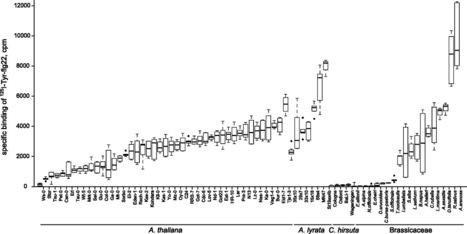




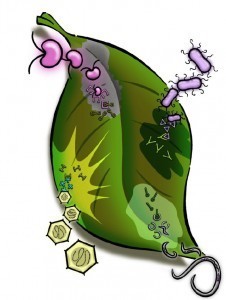

![Ag Biodiversity Weblog: Mapping the 1970 corn blight [caused by Race T of the fungus Cochliobulus heterostrophus (anamorph Bipolaris maydis)] | Plants and Microbes | Scoop.it](https://img.scoop.it/wIV4JUPX2_HNFH9mRlfq0jl72eJkfbmt4t8yenImKBVvK0kTmF0xjctABnaLJIm9)

